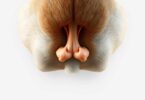You’ve probably seen it before—your furry companion pauses playtime to lick their paws repeatedly, followed by a dry, hacking cough. While these behaviors might seem harmless at first, they often leave pet owners wondering: Is this normal, or is something wrong?
Coughing in dogs is a natural reflex to clear irritants like dust or germs. Similarly, occasional paw cleaning is routine. But when these actions become frequent or intense, they could signal deeper issues. Seasonal allergies, for example, often trigger skin irritation that leads to excessive licking. Respiratory irritants might also cause persistent coughing.
What many don’t realize is how interconnected these symptoms can be. A dog with allergies might lick their paws due to itchiness while also inhaling allergens that lead to coughing. Left unchecked, minor irritations can escalate into conditions requiring professional care.
Understanding these signs is crucial. This article breaks down potential causes—from environmental factors to infections—and offers actionable steps for diagnosis and treatment. For a closer look at common causes of paw irritation, explore our detailed guide.
By staying observant, you empower yourself to make informed decisions for your pet’s well-being. Let’s dive into what these behaviors mean and how to address them effectively.
Understanding Canine Coughing and Paw Licking
Recognizing unusual patterns in your pet’s behavior is the first step toward addressing potential health concerns. Frequent coughing or persistent paw cleaning often hints at underlying issues that need attention.
Overview of Common Symptoms
Coughs in pets vary. A wet, phlegmy sound may suggest respiratory infections, while dry, repetitive hacking could point to irritants like dust or mold. Similarly, excessive paw licking—especially if focused on one area—often signals skin irritation or allergies. For example, pollen exposure might trigger itching, leading to reddened paws or fur loss.
Why These Behaviors Matter for Your Pet’s Health
Ignoring these signs risks worsening conditions. Allergies left untreated can escalate to infections. Younger animals and certain breeds, like Bulldogs, are more prone to environmental sensitivities. Early detection helps prevent complications. Simple steps, like wiping paws after walks, reduce allergen exposure. For severe cases, veterinary guidance ensures proper diagnosis.
Monitoring frequency and triggers provides clues. A cough that worsens at night or paw licking after outdoor play could indicate specific allergens. Staying observant allows timely intervention, improving long-term outcomes.
Identifying Causes Behind dog keeps licking paws and coughing
Understanding what drives these behaviors requires examining two key areas: external triggers and internal health challenges. Both factors often overlap, creating a cycle of discomfort that demands attention.
Environmental Irritants and Allergens
Airborne particles like pollen or dust frequently trigger allergic reactions. These substances irritate airways, leading to persistent coughing. Physical contact with grass, cleaning chemicals, or mold can also inflame paw skin, causing excessive licking.
Seasonal changes often worsen symptoms. For instance, springtime blooms release pollen that sticks to fur during walks. Wiping paws after outdoor activities helps reduce exposure. Hypoallergenic shampoos may soothe irritated skin in mild cases.
Underlying Medical Conditions and Infections
Bacterial or viral infections, such as kennel cough, produce harsh, dry coughing fits. Pneumonia or heart disease might also cause respiratory distress. Skin infections from constant licking create open sores prone to worsening.
Tracheal collapse, common in small breeds, intensifies coughing during excitement. A veterinarian can perform tests to rule out serious conditions. Bloodwork or X-rays often identify hidden issues needing targeted treatment.
Early intervention prevents minor irritations from escalating. Monitoring patterns—like symptoms worsening at night—helps pinpoint triggers. Professional guidance ensures accurate diagnosis when home care isn’t enough.
Steps to Diagnose Canine Respiratory and Skin Issues
Taking action when your pet shows unusual symptoms starts with knowing when to seek help. Early intervention often prevents minor issues from becoming severe. Here’s how to navigate the process effectively.
When to Consult Your Veterinarian
Persistent coughing lasting over 48 hours warrants a vet visit. Violent hacking or gagging could indicate infections like kennel cough. Skin redness, rashes, or hair loss around paws also require professional evaluation.
Track symptom patterns before your appointment. Note when coughing spikes—during exercise or at night. Document exposure to new environments or cleaning products. This data helps pinpoint triggers like air pollutants or allergens.
Diagnostic Procedures and Tests
Veterinarians often begin with throat exams and chest X-rays to check for blockages or pneumonia. Blood tests identify bacterial or viral infections. Skin scrapings analyze lesions for mites or fungal growth.
Accurate diagnosis separates temporary irritations from chronic conditions. For example, heart disease requires different care than seasonal allergies. Most cases improve with tailored treatments when caught early.
Follow your vet’s guidance closely. Simple steps, like using hypoallergenic shampoos or air purifiers, often complement medical plans. Addressing both respiratory and skin issues holistically ensures faster recovery.
Effective Home Care and Treatment Strategies
Managing your pet’s health requires blending practical home solutions with professional guidance. Small adjustments in daily routines often ease discomfort, while persistent issues demand targeted veterinary care.
At-Home Remedies and Grooming Tips
Start by soothing irritated skin with oatmeal baths or hypoallergenic wipes. These reduce itching without harsh chemicals. After outdoor activities, gently brush your pet’s coat to remove pollen or dust trapped in their fur.
Diet plays a role too. Omega-3 supplements strengthen skin barriers, while limited-ingredient foods minimize allergy triggers. Consider adding probiotics to support immune health—many pets show improvement within weeks.
Veterinary Treatment Options and Medication
When home care isn’t enough, consult your vet. Antihistamines or steroid creams might be prescribed for severe reactions. Medicated shampoos tackle bacterial infections caused by excessive licking.
For respiratory issues, antibiotics or cough suppressants address underlying infections. Always track symptom changes and share updates with your vet. This collaboration ensures treatments stay effective as conditions evolve.
Balancing these approaches helps pets recover faster. Simple steps like allergen-proofing your home complement medical plans, creating a holistic path to wellness.
Preventative Measures for Healthier, Happier Dogs
Proactive care plays a vital role in keeping pets comfortable and minimizing allergy flare-ups. Small daily adjustments create lasting improvements in skin health and respiratory function while reducing symptom recurrence.
Adjusting Diet, Exercise, and Environmental Factors
Start with dietary changes. Limited-ingredient foods with novel proteins like duck or salmon help many animals with sensitivities. Omega-3 supplements strengthen skin barriers, while probiotics support immune responses to seasonal allergens.
Schedule walks during low-pollen hours—early mornings or after rainfall. Post-walk routines matter: wipe paws with hypoallergenic wipes to remove irritants. Regular bathing with oatmeal shampoos prevents allergens from accumulating in fur.
Home environments need attention too. Vacuum floors twice weekly and wash bedding in hot water to eliminate dust mites. Air purifiers reduce airborne particles that trigger coughing fits during high-pollen seasons.
For persistent scratching, consider medicated sprays or coconut oil applications. These soothe inflamed skin without harsh chemicals. Always consult your vet before introducing new supplements, especially if your pet experiences recurrent issues.
Consistency is key. Combining these strategies creates layers of protection against environmental and food-related triggers. Over time, many owners report fewer allergy episodes and improved quality of life for their companions.
Key Takeaways for Supporting Your Dog’s Health
Caring for a companion with persistent symptoms starts with recognizing patterns. Frequent paw cleaning and respiratory distress often signal allergies or infections. Environmental triggers like pollen or dust are common culprits, while underlying conditions may require professional diagnosis.
Timely veterinary visits remain critical. Blood tests, skin evaluations, or imaging can pinpoint issues like bacterial infections or chronic respiratory problems. Early intervention prevents minor irritations from becoming severe.
Home care plays a supportive role. Omega-rich diets and hypoallergenic grooming reduce flare-ups. Air purifiers minimize airborne irritants, while regular paw cleaning after outdoor activities limits allergen contact.
Documenting symptom frequency and triggers helps veterinarians tailor treatments. Whether managing seasonal allergies or addressing infections, proactive monitoring improves outcomes. Combining preventive strategies with medical guidance ensures your canine friend enjoys a comfortable, active life.
FAQ
What environmental allergens commonly trigger these symptoms?
Pollen, mold spores, dust mites, and cleaning products often irritate sensitive pets. Seasonal changes or new household items may worsen reactions. Regularly washing bedding and using air purifiers can reduce exposure.
Could persistent paw licking indicate a bacterial infection?
Yes. Excessive grooming can break the skin’s barrier, allowing Staphylococcus or yeast infections to develop. A veterinarian might recommend skin cytology or prescribe topical/oral antibiotics after diagnosis.
How do food allergies contribute to coughing and skin issues?
Proteins like chicken, beef, or wheat may provoke immune responses, causing inflammation in airways or paws. Elimination diets under veterinary guidance help identify triggers while ensuring balanced nutrition.










Leave a Comment